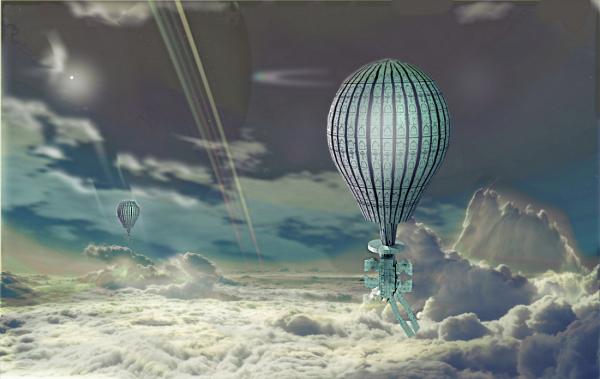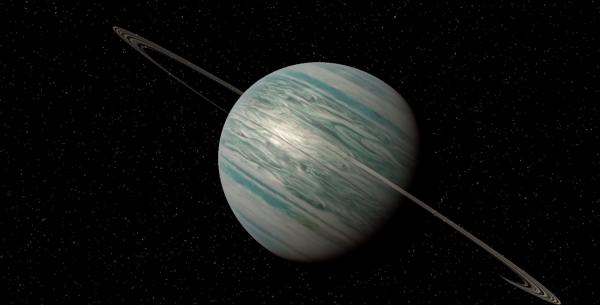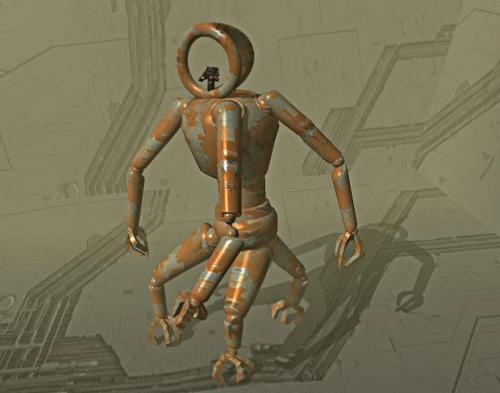BY LETTER
Arugula
Galactography > Regions of Space > Periphery
Galactography > Systems and Worlds > Systems & Worlds A - B
Galactography > Systems and Worlds > Systems & Worlds A - B
 Image from Steve Bowers | |
| The vecs of Arugula inhabit hot hydrogen balloon cities, where they refine helium3 for export. | |
Type K5V
Luminosity 0.19 x Sol
Distance from Sol 4513 ly
Galactic x,y,z (LY) 2051, 4017, -166
Constellation Vulpecula
Planet Arugula
Type Hydrojovian.
Diameter 50346 km
Day Length 13 hrs
Colonised 10202
 Image from Steve Bowers | |
| Arugula is a temperate gas giant near the outer edge of its star's habitable zone. | |
The name of this planet was randomly generated, just before they arrived. One tradition that many, although not all, colonists adopt is to refrain from naming the destination planet until they land there, or sometimes just before they land but can see the planet's disc with their normal sensory equipment. Most planets in the Terragen Sphere (and far beyond) have been imaged by the Argus Array long ago, the only exceptions being a few protoplanets in especially dense pre-stellar clouds. But many clades consider that seeing a world close-to with their own eyes (or functional equivalent) can give a better subjective impression than a telescopic image, however detailed.
The colony exports helium3 to a small population of spaceadapted humans, who arrived in the same colony ship. There is currently no transapient in this system.
After less than a hundred years the Arugulan vecs became discontent with their utopian society; after ten thousand years of research and experiment, social engineering was able to deliver a predictably pleasant lifestyle which the vecs were able to enjoy. But this was not enough - many vecs felt that their utopia lacked excitement and spontaneity, not to mention the sort of unresolved tension that many ancient civilisations had supposedly enjoyed. So the vecs voted to introduce a random element into their lives.
Stochastic Spontaneity
Using quantum-random generators, the Arugulans make certain key decisions at random; all their leaders are chosen using this method, making their political system a stochocracy. Even the decisions which are made using this system are themselves chosen randomly; on average less than 10% of all policies are chosen at random, but that is enough to give their legal and economic environment some curious quirks. For instance the prices of fabricated commodities are occasionally adjusted up or down at random, making markets a lottery on occasion. The transport systems that connect the habitats sometimes decide to avoid certain destinations; some bubblehabs might be cut off for varying lengths of time for no apparent reason.In their personal lives the Arugulans employ stochastic spontaneity to maintain an ever-changing social life - they often interact in ways that many outsiders find uncouth or even dangerous. Former colleagues might become apparent enemies, and vice versa, making conflict quite commonplace.
Arugulans often choose their home environment, work environment and method of transport at random, sometimes resulting in discomfort or even danger. Often the vecs can be found testing their climbing and balancing skills on the outside ledges of their bubblehabs, or on tethers strung between them; vecs that fall off are usually rescued before they reach the superfluid water ocean far below, but some are not - depending on the luck of the draw, since the rescue services often use random generators to decide who to save.
Some take the randomisation even further; they alter their own internal mindstates in order to change their personalities stochastically. This is relatively easy for a vec to do, but it can cause confusion among the friends and acquaintances of the individual concerned.
Certain trends seem to indicate that the randomisation of Arugulan society is becoming less extreme; for instance policy decisions are no longer completely random. A vote is held, then the randomiser is fine-tuned so as to select the policy to be enacted, with the odds of winning for each individual policy being equal to the amount of votes it gained. That way even unpopular policies that only get 10% of the vote may become law 1 in 10 times.
Additionally, some rescuers no longer use the randomiser when deciding who to save from the planet's deep oceans; the number of casualties that have occurred in the past is seen as excessive by many.
 Image from Steve Bowers | |
| An Arugulan vec, pondering the limits of randomness. | |
Related Articles
- Bubblehabs
- Cygexpa Outer Volume
- Hosoko Posthegemonic Management Network
- Light Speed Frontier
- Quantum-random trigger
- Stochocracy
- Wild Frontier - Text by M. Alan Kazlev
The romanticised and mythologized notion of the frontier, whether the outer solar system of the Solsys Era or the Outer Volumes and the Periphery today, as an exciting and lawless place. See also The Wilds.
Appears in Topics
Development Notes
Text by Steve Bowers
Additional material by Ryan B and MacGregor
Initially published on 27 September 2016.
Additional material by Ryan B and MacGregor
Initially published on 27 September 2016.






